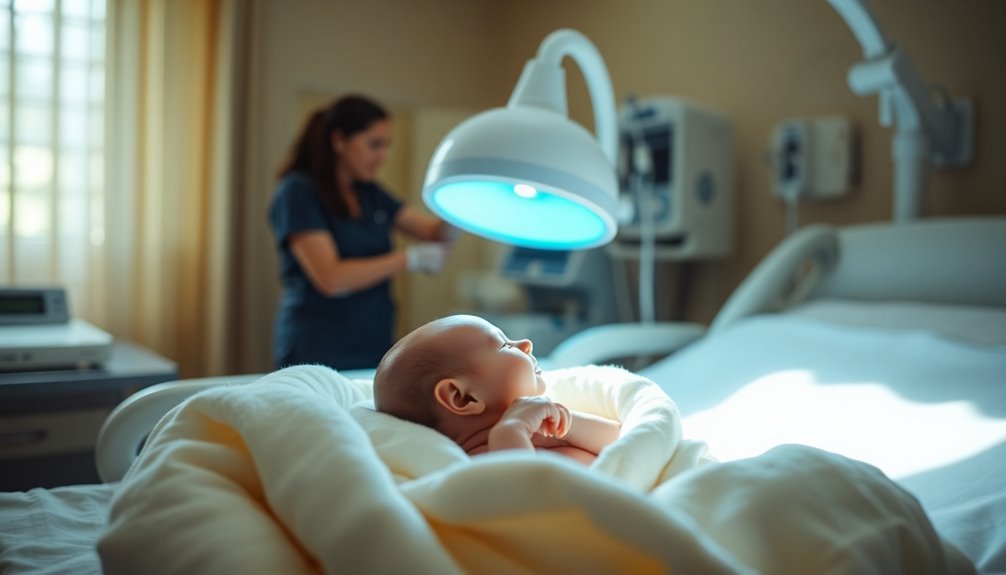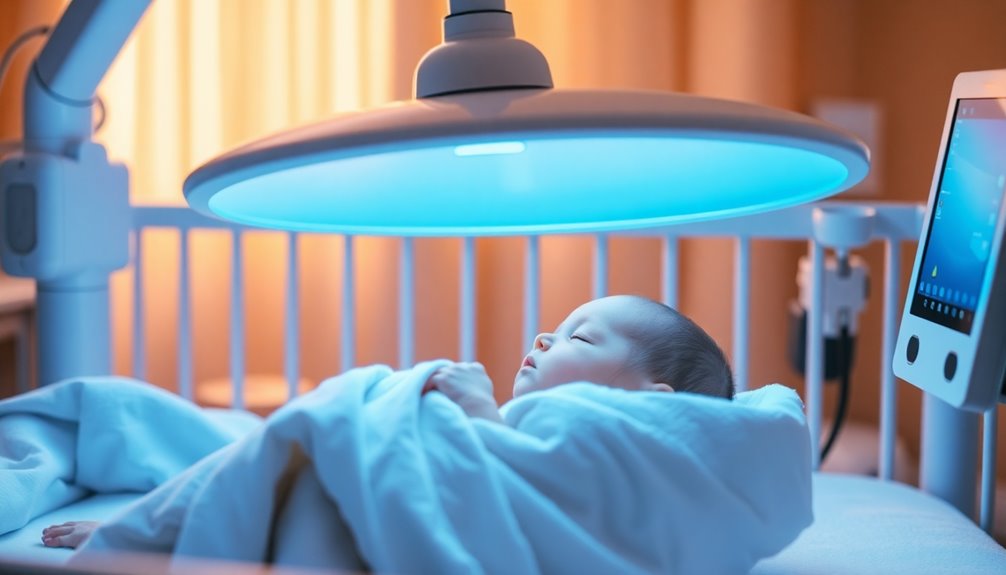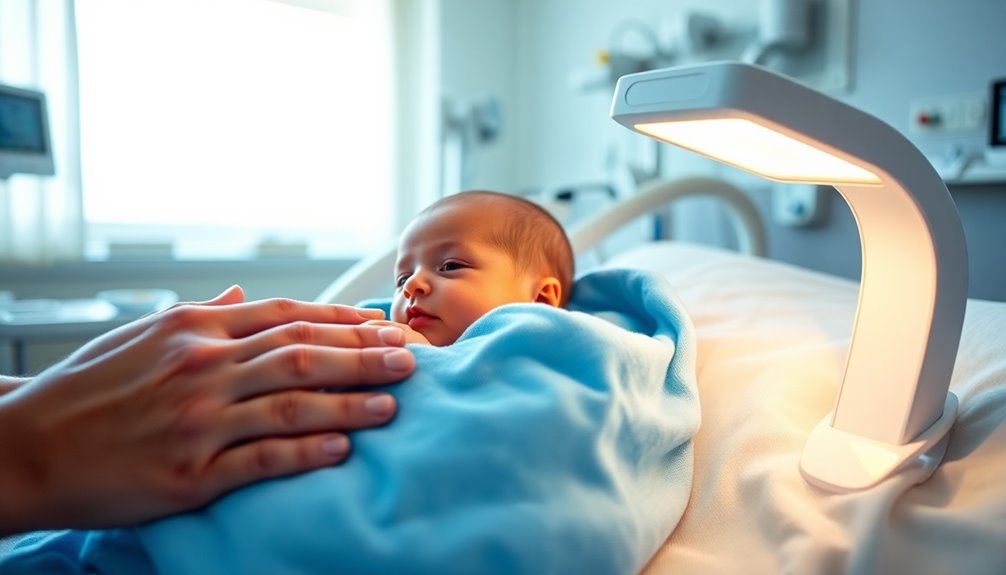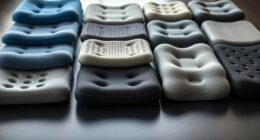If you're concerned about newborn jaundice, it's essential to act fast. This common condition causes yellowing of skin and eyes due to bilirubin buildup. Early detection is key, as treatment options like increased feeding and phototherapy can effectively lower bilirubin levels. Be sure to monitor your baby's feeding and hydration closely. If jaundice lingers or worsens, seek medical help immediately. To learn more about treatment methods and care strategies, keep exploring this topic.
Key Takeaways
- Newborn jaundice affects many infants, with early detection crucial for preventing complications like kernicterus.
- Treatment options include phototherapy, which uses blue lights to break down bilirubin effectively.
- Increasing feeding frequency helps eliminate bilirubin from the baby's system.
- Severe cases may require hospitalization and close monitoring or exchange transfusion for dangerously high bilirubin levels.
- Follow-up visits are essential to ensure bilirubin levels remain safe and to monitor the baby's health.
Understanding Newborn Jaundice

Understanding newborn jaundice is essential for parents and caregivers. Jaundice affects up to 60% of full-term newborns and can be more common in premature babies, often appearing within the first week.
Understanding newborn jaundice is crucial, as it impacts up to 60% of full-term infants, particularly in the first week.
It's characterized by the yellowing of the skin and eyes due to bilirubin buildup, a byproduct of red blood cell breakdown. The immature liver of newborns may struggle to process bilirubin effectively.
There are types of jaundice, such as physiological jaundice, which usually resolves within two weeks, and breastfeeding jaundice, often linked to inadequate milk intake.
Diagnosis involves physical exams and blood tests to measure bilirubin levels. While most cases aren't serious, early detection and treatment are vital to avoid complications like kernicterus.
Types of Newborn Jaundice

When it comes to newborn jaundice, you'll find several types that can affect your baby.
Physiologic jaundice usually appears a few days after birth and resolves on its own, while breastfeeding jaundice can occur if your baby isn't getting enough milk in the first week.
Hemolytic disease, on the other hand, arises from red blood cell breakdown, often due to blood type issues between you and your infant.
Physiological Jaundice Overview
Physiological jaundice is a common condition that affects many newborns, typically surfacing between the second and third day of life as their livers mature.
This condition is marked by yellow coloring of the skin, starting from the face and progressing down the body.
Here are some key points about physiological jaundice:
- Up to 60% of full-term infants and 80% of premature infants experience this condition in their first week.
- Bilirubin levels usually peak around day three and naturally decline within 1 to 2 weeks.
- Unlike pathological jaundice, physiological jaundice isn't linked to any serious health issues, as it's just a normal response to the baby's liver development.
Generally, no treatment is needed as bilirubin levels decrease naturally.
Breastfeeding Jaundice Explained
As newborns adjust to life outside the womb, some may face challenges with bilirubin elimination, particularly in breastfeeding situations.
Breastfeeding jaundice occurs when babies develop jaundice due to insufficient breast milk intake, which leads to elevated bilirubin levels. This condition typically arises within the first week of life and is more common among breastfed babies, affecting about 20% of them.
To help reduce bilirubin levels, it's vital that you guarantee your newborn receives enough breast milk through early and frequent feedings, ideally 8-12 times daily.
Unlike breast milk jaundice, which develops later and is caused by substances in breast milk, breastfeeding jaundice often requires additional support and monitoring to resolve effectively.
Hemolytic Disease Impact
Hemolytic disease can greatly impact newborns by causing jaundice due to the rapid breakdown of red blood cells. This condition elevates bilirubin levels, often leading to more severe jaundice compared to physiological jaundice.
It's important to recognize the causes and implications of hemolytic disease:
- Rh Incompatibility: When the mother's blood type is Rh-negative, and the infant's is Rh-positive.
- ABO Incompatibility: When the mother has type O blood and the infant has type A or B blood.
- Complications: Untreated jaundice can lead to serious issues like kernicterus, resulting in long-term neurological damage.
Timely treatment is essential for managing hemolytic disease and preventing complications in newborns.
Early detection through blood tests is crucial to guarantee your baby's health.
Importance of Early Detection

Early detection of jaundice in newborns is essential for effective treatment.
If you notice symptoms like yellowing skin or poor feeding, it's important to get medical help right away.
Monitoring bilirubin levels regularly can prevent serious complications and guarantee your baby stays healthy.
Recognizing Symptoms Early
How can you tell if your newborn is developing jaundice?
It's vital to recognize the symptoms early, as timely intervention can prevent complications.
Look for these signs:
- Yellow color: Check your baby's skin and eyes for any yellowing, starting from the face and moving downwards.
- Poor feeding: If your newborn seems lethargic and isn't feeding well, this could indicate high bilirubin levels.
- Medical evaluation: Don't hesitate to consult a healthcare provider if you notice these symptoms of jaundice; early detection is essential for effective treatment.
Monitoring Bilirubin Levels
Recognizing the symptoms of jaundice is just the first step; monitoring bilirubin levels is essential for ensuring your newborn's health. Bilirubin in the blood typically peaks between 3-7 days after birth, making timely assessments vital.
Regular bilirubin level assessments can help prevent complications like kernicterus, which may cause severe neurological damage if untreated. Using transcutaneous bilirubinometers allows for non-invasive monitoring, enabling frequent checks without blood draws.
However, if these measurements indicate high bilirubin levels, blood tests become necessary for precise evaluation. Early detection through monitoring can lead to effective treatments, such as phototherapy, markedly reducing the risk of serious health issues associated with neonatal hyperbilirubinemia.
Stay proactive in monitoring to protect your baby's well-being!
Diagnosis of Jaundice in Infants

When you notice a yellow tint in your baby's skin, it's crucial to determine if it's jaundice. Diagnosis primarily relies on visual assessment, but it's confirmed through blood tests measuring bilirubin levels.
Recognizing a yellow tint in your baby's skin is essential for diagnosing jaundice, confirmed through bilirubin blood tests.
Here's what you can expect:
- Transcutaneous Bilirubinometer: This device estimates bilirubin levels non-invasively by measuring light absorption through the skin.
- Heel Prick: If jaundice is suspected within the first few days, a heel prick may be necessary to obtain a serum bilirubin measurement.
- Assessment of Severity: Doctors consider your baby's age, bilirubin levels, and potential risk factors to evaluate the severity of jaundice.
If jaundice persists beyond two weeks, further blood tests may reveal an underlying cause, such as blood type incompatibility or infection.
Treatment Options for Jaundice

Although jaundice in newborns can be concerning, various effective treatment options are available to help manage the condition.
If your baby has jaundice, increasing feeding frequency is essential. For breastfed infants, aim for 8-12 feedings daily to help eliminate bilirubin.
Light therapy is a common treatment that utilizes special blue lights to alter bilirubin's structure, making it easier for the body to process.
In more severe cases, your baby may need a hospital stay for close monitoring. If bilirubin levels reach dangerous heights, an exchange transfusion might be necessary to reduce them.
Remember to schedule a follow-up visit within 2 to 3 days after discharge to confirm your baby's bilirubin levels remain safe.
Phototherapy: How It Works

Phototherapy is a key treatment method for managing jaundice in newborns, effectively breaking down bilirubin in the skin. This treatment uses special blue lights to help your baby's liver eliminate bilirubin more efficiently.
Phototherapy is an essential treatment for newborn jaundice, utilizing blue lights to enhance bilirubin breakdown.
It can be administered through a light-up bed or a fiberoptic blanket, ensuring comfort during the process.
Here are three important points about phototherapy:
- It typically shows results within 24 hours, with notable drops in bilirubin levels.
- Close monitoring of your newborn's hydration and feeding is essential, as treatment can increase fluid loss.
- Side effects, like watery diarrhea and skin rash, are usually mild and resolve after treatment ends.
With effective management, your baby's jaundice can be considerably reduced.
Home Care and Monitoring

Caring for your jaundiced newborn at home involves close monitoring and consistent feeding to help lower bilirubin levels effectively.
You'll want to make sure frequent feedings every 2 to 3 hours, especially if you're breastfeeding, aiming for 8-12 feedings daily. This not only promotes hydration but also aids in reducing jaundice.
If your baby is undergoing phototherapy, be aware of potential side effects like watery diarrhea and dehydration, so stick to the feeding schedule.
During home care, closely watch your baby's weight, intake, diaper output, and skin color.
If you notice any signs of worsening jaundice, such as yellow returning after treatment, contact your healthcare provider, especially if jaundice persists beyond 2 to 3 weeks.
When to Seek Medical Help

When should you be concerned about your newborn's jaundice? It's important to pay attention to certain signs that warrant medical help. Here are three key situations to keep in mind:
- Jaundice appears after the first 24 hours of life, which may indicate an underlying issue that requires further evaluation.
- If your baby shows signs of poor feeding, lethargy, or decreased responsiveness, it's vital to seek medical attention immediately.
- Contact your healthcare provider if jaundice persists for more than 2 to 3 weeks or if yellowing returns after treatment has stopped, as this could suggest elevated bilirubin levels needing treatment.
Always trust your instincts as a parent. Your newborn's health is paramount, so don't hesitate to reach out for help.
Long-term Outlook for Jaundice in Newborns

Although most cases of newborn jaundice resolve quickly and without lasting effects, it's vital to monitor your baby's health closely.
Typically, treatment helps reduce bilirubin levels within two weeks for formula-fed infants and up to a month for those on breast milk.
Early detection is key to preventing complications like kernicterus, which can lead to severe long-term effects, including cerebral palsy and hearing loss.
If jaundice persists beyond two weeks, follow-up care is important for further evaluation.
Fortunately, the prognosis for infants with jaundice is excellent, and with proper management, most babies recover fully without any lasting health issues.
Keep an eye on your baby's progress to guarantee a healthy future.
Frequently Asked Questions
What Is the Fastest Way to Cure Jaundice in Newborns?
The fastest way to cure jaundice in newborns is through phototherapy. This treatment uses special blue lights that help change bilirubin's structure, making it easier for your baby's body to eliminate it.
Frequent feedings of breast milk or formula are also vital, as they promote bilirubin elimination through stool.
In severe cases, an exchange transfusion might be necessary to quickly lower bilirubin levels, so monitoring is essential throughout the treatment process.
How Many Days of Phototherapy Are Needed for a Newborn?
Think of phototherapy as a warm sunbeam helping your newborn shine bright.
Typically, you'll need 1 to 2 days of this light therapy, depending on how high the bilirubin levels are and how well your baby responds.
If the levels remain stubbornly elevated, it might stretch beyond that.
Daily check-ups will help guarantee everything's on track, so your little one can bask in the glow of good health soon.
What Type of Therapy Would Be Used for a Newborn Baby With Jaundice?
For a newborn baby with jaundice, phototherapy's your go-to treatment. It uses special blue lights to break down bilirubin in the skin.
If you want more mobility for your baby, fiberoptic blankets can be a great alternative or addition.
In severe cases, an exchange transfusion might be necessary to quickly reduce bilirubin levels.
Don't forget to feed your baby frequently, as it helps eliminate bilirubin through their digestive system.
How Do I Know My Newborn Jaundice Is Getting Better?
You can tell your newborn's jaundice is improving by watching for a decrease in the yellow color of their skin, starting from the face and moving downwards.
Regular bilirubin checks will show if levels are dropping. Increased feeding frequency will help, so aim for 8-12 times daily.
You should also notice your baby becoming more active and responsive, with fewer signs of lethargy, poor feeding, or irritability as treatment progresses.
Conclusion
So, if you thought your baby's yellow glow was just a trendy new fashion statement, think again! Newborn jaundice isn't just a cute accessory; it's a condition that needs attention. Remember, getting your little one checked early might save you from endless internet rabbit holes about liver function and light therapy. So, don't wait for those jaundiced selfies to go viral—act fast, and give your baby the healthy future they deserve!









